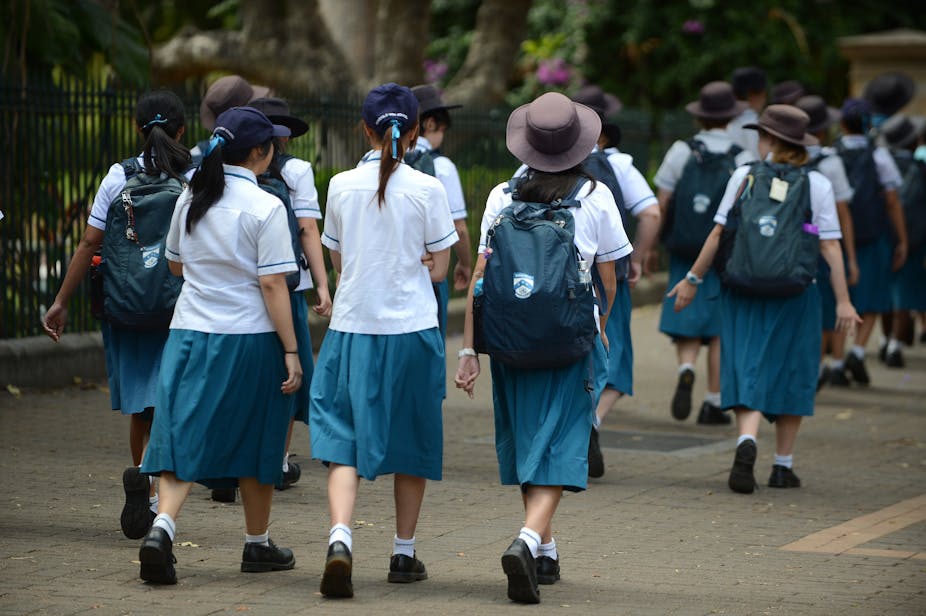Education minister Christopher Pyne says it’s necessary to go “back to the drawing board” on schools funding and abandon the previous government’s funding reforms – commonly known as the Gonski model.
After calling the Gonski model “unimplementable”, Pyne said that by the end of next year, the Coalition will develop a new funding model. It is unclear what this “flatter, simpler, fairer” policy Pyne is advocating will really look like. Yesterday, he ruled out a return to the Howard SES model but in previous interviews, he has remained ambiguous.
There certainly were flaws in the Labor government’s interpretation of the Gonski review’s recommendations, including the way it distributed funds and sourcing the money from the higher education sector.
But Minister Pyne, before we go “back to the drawing board”, let’s have another look at why the Gonski Review was initiated and why we allegedly need further debate on funding models.
Why was the Gonski Review initiated?
The Gonski Review cost taxpayers thousands of dollars, consisted of six expert panelists, met with hundreds of professionals and stakeholders, and compiled more than 7000 written submissions from the public.
The review came about because ever since the existing funding model was introduced by the Howard government in 2001, known as the socio-economic status (SES) model, a large volume of peer-reviewed academic research concluded that the funding model was “unhelpfully complex and exceedingly opaque”.
The socio-economic status (SES) model funds schools within the private sector. A large part of this funding is based on the number of enrolments within a school. Or in other words, cash for customers. Schools also receive money as based on their socio-economic status (SES) score. This “score” measures the cohort of students, not the individual, and bases a score on the residential address of the cohort. As Gonski panelist Kathryn Greiner commented, this score lacks accurate data and leads to inefficient funding.
There are three different streams of funding within this SES model and it is almost impossible to tell where funds are coming from or going to.
Hence, one of the primary aims of the Gonski Review is to achieve transparency of funding. This cannot be understated. Surely, we want to know where our taxpayer dollars are going? Due to recurrent grants based on average cost measurements and confusing indexation arrangements, it is not always clear which level of government is providing funding.
Indeed, our current funding system completely lacks coordination and this leads to a duplication of funding efforts. In other words, some get more, some get less.
This matters because Australia is not hitting the A grade when it comes to educational achievement. The global ranking system – the Programme for International Student Assessment – shows that Australia has recorded consistent declines in educational achievement for the last ten years.
The gap between our high and low achievers is increasing. What’s more, Australia demonstrates a stronger relationship, when compared with our OECD neighbours, between educational achievement levels and socio-economic status.
Funding advantage, not disadvantage
This is the primary point to consider when thinking about our current funding model and comparing it to the proposed funding model. Currently, Australia spends more on advantage and less on disadvantage.
In comparison to other OECD countries, Australia spends above-average on private schools, meaning the Independent and Catholic sector. Australia also spends less taxpayer dollars on public schools in comparison to what the average OECD country spends, even though this is where you’ll find most of the disadvantaged students.
There is no other country in the OECD world that funds independent schools as favourably as Australia does. The majority of OECD countries retain an independent sector that is truly “independent”. Our independent school is government-dependent, in that it garners almost half of its net-recurrent income from taxpayer subsidies – 45% in total.
The Gonski model
Of course, the Gonski funding model is contentious. It proposes to attribute more money to where it is needed. It adds funding loads to individuals with a disability or students who live in a remote area, possess lower English language proficiency, amongst others. The Independent school sector feels threatened by the proposed model and are scared of losing funding (which increased under the Howard SES model).
The Abbott government has absolutely no interest or intention in modifying the current funding system. Previously, Abbott declared that the Gonski reforms were unnecessary, as there is nothing fundamentally wrong with our funding system.
They will continue to delay the Gonski funding for as long as they can, and Minister Pyne will continue to claim outlandish claims, entirely lacking in research-based evidence. They will do whatever they can to delay and disrupt the Gonski funding model. Their purpose is to increase the scope of education privatisation and the Gonski funding model will do the opposite.
Keeping in mind that the most successful systems are those that “combine quality with equity”, we need to ask ourselves, which model is fair and equitable? If the government doesn’t acknowledge the underlying problems that the Gonski model sought to address, it’s hard to see how a fairer system can develop.

